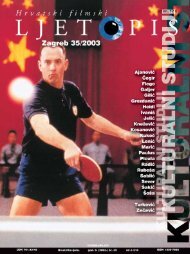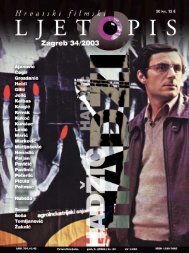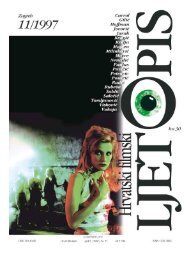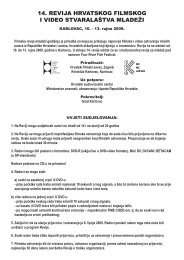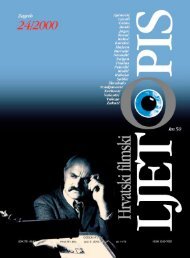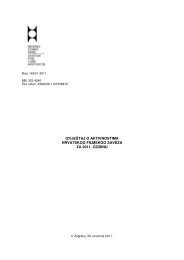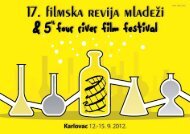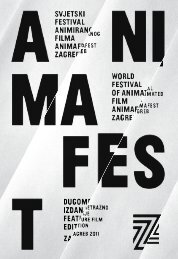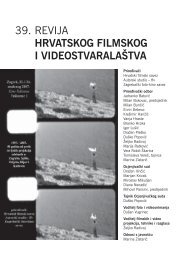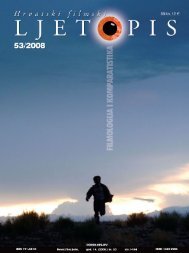Hrvatski filmski ljetopis, broj 15 (1998) - Hrvatski filmski savez
Hrvatski filmski ljetopis, broj 15 (1998) - Hrvatski filmski savez
Hrvatski filmski ljetopis, broj 15 (1998) - Hrvatski filmski savez
Create successful ePaper yourself
Turn your PDF publications into a flip-book with our unique Google optimized e-Paper software.
RESEARCH AND STUDIES: FILM AND VIDEO<br />
TECHNOLOGY<br />
UDC: 621.37<br />
621.38<br />
Branko Bubenik<br />
Deterioration of Video Originals<br />
in Use<br />
A survey of the results in the research conducted<br />
on the degree of degeneration of audiovisual documentation<br />
registered on audiovisual analog technology<br />
during reproduction and re-recording.<br />
In the introduction, the author analyses the historical development<br />
of the registration of image and sound (mechanical,<br />
photochemical, electromagnetic, optical digital registration)<br />
and establishes their contribution. In order to determine the<br />
behavior of the content of video documents in migration,<br />
from generation to generation, that is the transfer of information<br />
akin to genetic copying, the degradation of two video<br />
formats was researched — VHS (an amateur video format)<br />
and Betacam SP (a componential analog format).<br />
Through experimentation with video documents on the<br />
VHS format, it was found that the image completely fell<br />
apart on the ninth generation copy (static noise overwhelmed<br />
the image’s signal). Nevertheless, the sound quality was<br />
still satisfactory, which shows that the degradation of image<br />
is not linear in every frequency range, but rather more pronounced<br />
in high frequency ranges.<br />
The result of experimentation on the degree of degradation<br />
of signals recorded on Betacam SP tapes during content migration<br />
shows an unexpected stability in the recorded image<br />
and a small losses in the transfer phase from one tape to<br />
the other in so-called generational copying. Even though<br />
manufacturers of Betacam television equipment guarantee<br />
the broadcast quality of images up to the third generation,<br />
tests showed that the image quality was very good in the<br />
fifth generation, good in the eighth generation and still usable<br />
in the <strong>15</strong>th generation.<br />
Unlike the VHS amateur format where the image was already<br />
completely degraded in the 10th generation, the signal<br />
stability of Betacam equipment and tapes during content migration<br />
was established (according to signal/noise ratios and<br />
the frequency range). About 50% of the signal was lost in<br />
the <strong>15</strong>th generation, therefore it can be assumed that complete<br />
degradation would happen somewhere between the 25th and 30th generation copy.<br />
UDC: 791.44.071(091)<br />
Kre{imir Miki}<br />
A Short Outline of the History of<br />
Cinematography<br />
A concise survey of the range of cinematographic<br />
ingenuity in relation to the development of film<br />
technology from the beginning of film to the present<br />
day.<br />
In the introduction, the author stresses the role of Lumieres<br />
who used every film type of shot in the film L’arrivée d’un<br />
<strong>Hrvatski</strong> <strong>filmski</strong> <strong>ljetopis</strong> <strong>15</strong>/<strong>1998</strong>.<br />
train. Moreover, Méliès used double and triple exposures,<br />
changes in shooting speed, stop motion and a combination<br />
to models and characters. G. A. Smith discovered the detail<br />
while E. S. Porter affirmed the close-up and showed the importance<br />
of choosing shooting angles, camera positions and<br />
shot compositions. The author cites D. W. Grifith’s cameraman<br />
B. Bitzer as the first great cameraman in the history of<br />
film. The golden age of Soviet film is marked by cameramen<br />
like M. A. Kaufman, A. D. Golovnja, D. P. Demucki, as well<br />
Eisenstein’s associate E. K. Tissé, and A. N. Moskvin in the<br />
sound era. Their contribution are documentary photography<br />
and the discovery of hidden camera techniques. In<br />
the Scandinavian film, the author cites the contribution of J.<br />
Jaenzona (The Phantom Coach Sjöström, 1921.) as a master<br />
of the romantic-mystical atmosphere that shows the bond<br />
between man, his emotions and the might of nature. A tie<br />
with fine art can be found with German Expressionist cameramen<br />
(W. Hameister, A. Wagner, K. Freund).<br />
In the first years of sound film, it is impossible not to mention<br />
Stroheim’s cameraman G. Rittau. Cinematographic<br />
achievements can be found in the musical with the discovery<br />
of ornamental, kaleidoscopic ballet scenes (B. Berkeley), as<br />
well as in the new cinematographic prospects in color film<br />
(R. Rennahan).<br />
Among individual achievements in cinematographic craft he<br />
mentions the films of L. Riefestahl, and especially G. Toland,<br />
the cameraman on Welles’ Citizen Cane, who used<br />
deep focus photography, unusual angles, and complex camera<br />
moves exceptionally well.<br />
While the films of the thirties and forties are known for their<br />
effectively modeled lighting, well-lit close ups and use of<br />
lenses of a medium focal length, neorealism brings with it a<br />
maximally realistic image, and the style of film noir uses low<br />
light tonality, unusual angles, emphasized compositions and<br />
deep focus shots.<br />
The modernism of the 60’s was based on new film materials<br />
and the photography is well-known for it unusual angles<br />
and shot compositions with accented camera movement and<br />
the use of narrow lenses with long focal lengths...<br />
In the beginning of the 70’s cinematographers use sensitive<br />
film stock, small yet powerful lighting equipment and fast<br />
lenses. It seems that during this period they were trying to<br />
get away from realistic images by making them softer, by lowering<br />
contrast and definition, by desaturating colors, etc.<br />
Contemporary (especially American) film is more refined<br />
and technically accomplished, and computer technology is<br />
evermore present which puts cinematographers in a new position<br />
by giving them a new role in and new possibilities in<br />
the future development of cinema.<br />
Kre{imir Miki}<br />
Bibliography of Cinematography<br />
Books<br />
(A survey of the literature on cinematography from 1980 to<br />
July <strong>1998</strong> which is still available for sale)<br />
185




